
Mission Statement:
"To advance through research, education and symposia, an increased public awareness of the Cape Fear region's unique history."

The Forks Road Defense of Wilmington
February 20-21, 1865
Cape Fear Historical Institute Papers
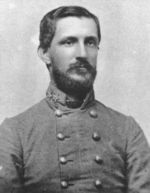 |
Major-General Robert F. Hoke |
Prelude to Forks Road: Fort Anderson
Subsequent to the fall of Fort Fisher on January 15, 1865,
Northern forces began a cautious advance on the city
of Wilmington from both sides of the Cape Fear River.
After the evacuation of Fort Anderson on the west side
of the river on February 19 by his subordinate,
Brigadier General Johnson Hagood (future governor
of South Carolina) and his South Carolinians,
Major General Robert F. Hoke had to abandon his
defensive position across the river from that fort,
at Sugar Loaf. Without any strong fortifications to
fall back on, Hoke knew that defending
the city would be difficult.
Before evacuating Fort Anderson, General Hagood had held
on against an enemy with overwhelming strength, but his
position was compromised by black residents aiding the
enemy. Incidents such as this had also brought disastrous
results to North Carolina patriots in 1781:
"when British forces under the command of Lord Cornwallis advanced toward the city, slaves flocked to the British lines
in hopes of gaining their freedom; they then assisted in the
plunder of nearby farms and plantations, and stood by
when the Redcoats finally captured Wilmington
and sacked it."
In a May 1st, 1900 address entitled "Defense of Fort Anderson,
1865," Capt. Eugene S. Martin described the action
there as follows:
"The fort proper was commanded by Colonel [Wilmingtonian
John J.] Hedrick with the 40th North Carolina Regiment;
on his right was [Captain Abner] Mosely's [Sampson
Artillery] Battery of Whitworth guns, then came the light
artillery around this [St. Philips] Church, then Major
MacRae's Command, and on our extreme right
Colonel Simonton's Regiment and other South Carolina
troops, the whole command under General Johnson
Hagood...His headquarters were on the road to
Orton [Plantation, now Highway 133]."
The shelling of the fort was incessant from enemy monitors
and gunboats on the 18th and 19th of February which
destroyed many of the tombs around the Church. Just after
midnight on the 18th [Saturday] General Hagood quietly
evacuated Fort Anderson, leaving "Some of the dead [who]
were still in the gun chambers and along the lines, whlie
some had been carried into that sacred Edifice and lay
there with their pale faces turned toward the
silent stars above them..."
The enemy pickets discovered empty fortifications in
front of them as they carefully probed the fort's defenses
at daylight. In his "Land of the Golden River", author
Lewis Philip Hall describes the unopposed
enemy advance:
"Once Northern troops entered the abandoned
Fort Anderson, they were drawn to the historic
graveyard and ruins of nearby St. Philips Church
where they “dug up the remains of the coffins,
broke open the tombs and scattered the bones,
looking for jewelry and silver coffin plates; at which
time many of the gravestones were destroyed”
Before departing the fort for their advance on Wilmington,
Northern troops defaced the Church and removed
its cornerstone.
Author James Laurence Sprunt wrote that patriot
and Judge Parker Quince's "tomb though battered
by Northern shellfire and marred by vandals, [it] still
remains as one of the most imposing there..." Another
Northern cannonball "struck and demolished a s
imple tombstone bearing the epitaph
"Here lies the body of Benjamin Smith, one time
Governor of North Carolina."
When only 21 years old, Smith served as an aide
to General Washington in the retreat from Long Island
in August 1779, and performed his duty gallantly at
Fort Moultrie that same year while driving the
British from South Carolina.
Fight at Town Creek
The Northern forces then caught up with the South Carolinians
at the brief battle of Town Creek, where 3000 troops
assaulted Hagood’s thin line of 450 in their new defensive
position. It was a one-sided battle though an Ohio
regiment sustained heavy casualties while advancing on
the Edenton Bell Battery of the 3rd North Carolina Artillery.
As a testament to the overwhelmed patriots bravery, a Northern
officer commented that the North Carolinians “stood their ground
to the last and did not surrender until the guns were taken
from their hands.” A 12-pounder howitzer of that Battery,
the “Saint Paul,” (so named as it was cast from the melted
bronze bell of Saint Paul’s Episcopal Church of Edenton,
North Carolina) was captured by the invaders.
Wilmington-natives with Hagood's forces included Captains'
John D. Taylor and Edward B. Dudley (Anderson Artillery)
of the Thirty-Sixth NC Regiment; Lt. William Calder, adjutant
of First NC Battallion, Heavy Artillery; Lt. John Hampden
Hill of the Fortieth Regiment; Capt. Eugene S. Martin
(Ordnance Officer for Hagood); and
Captain John T. Rankin.
Another veteran of the Fort Anderson and Town Creek
battles was Gabriel J. Boney, a private in the 3rd NC Artillery.
His capture at the Battle of Bentonville on March 19th, had
him spend the remainder of the war at Point Lookout prison
of war camp. Boney is known for the legacy of $20,000
upon his death in 1915, specifically to fund the Confederate
Memorial (1924) monument to his comrades now
standing at Third and Dock Streets in Wilmington.
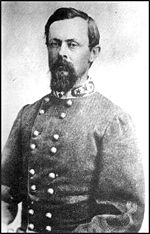
General Johnson Hagood
Also with Hagood's force were the remnants of Wilmingtonian
Major Alexander MacRae's 1st Battalion, North Carolina Heavy
Artillery which had fought valiantly at Forts Fisher and Anderson.
MacRae was the father of Brigadier General William MacRae
who distinguished himself in Lee's Army of Northern Virginia.
Both MacRae's are buried in Wilmington's Oakdale Cemetery.
General Hoke Lays His Plan of Defense:
Hoke knew enemy strategy as he was in possession of a captured
order from Northern General Schofield that the ultimate goal was
to reach Goldsboro, and linking up with Sherman’s forces that
had been ravaging the Carolinas. Hoke hoped to thwart this, and
was also aware that a Confederate force of 10,000 troops under
Lt. General William J. Hardee was fast approaching
Wilmington from South Carolina.
He was determined to create a strong defensive work before
Wilmington in order to hold the city until Hardee arrived.
Nor would a Northern naval advance up the Cape Fear River
be easy, Hoke had artillery batteries above Sugarloaf (Town
Creek, Nine Mile, Eagle's Island, and Forts Meares, Campbell,
Lee and Stokes), on both sides all the way up to the
city of Wilmington itself.
At both post-Fort Fisher defensive lines of Sugar Loaf and
later Forks Road, Hoke’s entrenchments were formidable
obstacles facing Northern commanders, and as he deployed
his veterans across the peninsula below Wilmington and
easily fought off repeated assaults, he is worthy of the title
“the Stonewall of Forks Road.” And it was only the success
of vastly overwhelming Northern forces on the western side
of the Cape Fear at Fort Anderson which forced Hoke to
make a strategic withdrawal.
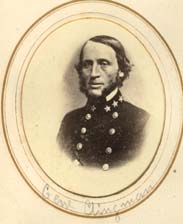
Thomas L. Clingman as Colonel
General Hoke’s division consisted of four brigades commanded
by Brigadier General Alfred Colquitt (a future governor of
Georgia), Brigadier General Thomas L. Clingman (who was
convalescing, Col. William Devane in his place), Brigadier
General W. W. Kirkland, and the aforementioned Hagood.
The entire force was made up of North Carolina patriots except
for the South Carolinians of Hagood, and Georgians of Colquitt.
Among Hoke’s Cape Fear defenders were Wilmington natives
Capt. John J. Hedrick, Capt. Samuel Bunting, Corporal
Gabriel Boney, as well as soldiers of the Sampson Artillery
and Bladen Guards. Also near Hoke’s lines were the MacRae
and Parsley batteries, named for local patriots, and located
at Young’s Pond at the “extreme northeastern tip of
Greenfield Mill Pond, on the old Federal
Point Road (an extension of 12th Street).
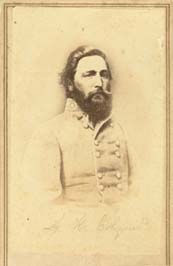
General Alfred Colquitt
Dug In At Forks Road:
On the east side of the river, 3000 of Hoke's men had
entrenched at Forks Road, about 4 miles southeast of
Wilmington and now the site of the Cameron Art
Museum. It is reported that the entrenchments
extended from the Cameron site to the Cape Fear
River, and in the opposite direction toward
present-day Eastwood Road.
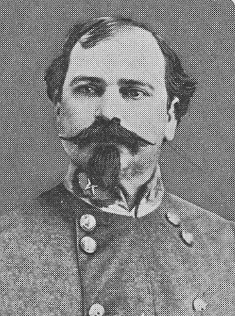
General William W. Kirkland
The Northern force opposing Hoke was being guided by
Jacob Horne, a local man who betrayed his State, family and
brother -- the latter was among Hoke’s defenders. On February
20th, Northern forces opposing Hoke numbered about 8500
and in probing his position, sent five US Colored Troop (USCT)
regiments comprising 1600 men in repeated and near-suicidal
assaults that day and the next, getting no closer to
Hoke's breastworks than 150 yards.
As Hoke’s lines were stretched out, the brunt of the Northern
attack was received by General Clingman’s Brigade of North
Carolinians, numbering about 900 men, under Colonel Devane.
It is notable that Clingman's command included Captain Lippitt's
51st North Carolina that routed the 54th Massachusetts
at Battery Wagner, near Charleston, in July 1863.
The 54th Massachusetts was a black regiment led by
white northern officers, as were the black troops that assaulted
Hoke's well-entrenched defensive position (see note below).
According to Chris Fonvielle’s The Wilmington Campaign,
“Clingman’s [Brigade] fire ravaged Wright’s (USCT) brigade
with continuous volleys of musketry, while the Rebel artillery
assisted with barrages of iron case shot.” The attackers were
swept off the field by a murderous fire from the Wilmington
Horse Artillery’s 6 and 12-pounders. Realizing further attacks
would be futile, the black troops “promptly erected a defensive
line” at the front while white Pennsylvania troops were
entrenched a half-mile to the rear.
It was common by 1865 for US Colored Troops to be used in
support roles, or assault troops if white soldiers saw the potential
for great casualties—as at Battery Wagner near Charleston.
Also, the performance of black soldiers in past battles such
as Battery Wagner, Olustee and the Crater made Northern
commanders hesitant to use them in critical assaults.
(see note below).
At Forks Road, the Northern gunboats were out of range and
could not effectively support the attack of the USCT, which helped
ensure the failure of the assault. Several Northern gunboats
grounded in the shallows of the Cape Fear River below
Wilmington, and lighter craft were severely damaged or driven
off by the strong artillery batteries Lee, Campbell, Meares
and Davis just south of the city and effectively anchoring
Hoke’s western flank. The Northern transport Thorn blew
up in the river after striking a submerged torpedo at Orton
Cove, one of twenty known to have been strategically placed
to destroy enemy ships.
Despite Hagood’s defeat at Town Creek making Hoke’s
position at Forks Road increasingly untenable, Wilmington’s
defenders defiantly floated mines downriver to surprise
Northern gunboats, killing several sailors and nearly sinking
the transport Osceola.
Late in the evening of the 20th, Hoke telegraphed the approaching
Hardee that with his two brigades soon in Wilmington, the city may
yet be saved from the invader.
On February 21, Hoke’s firmly entrenched lines at Forks Road
stoutly resisted a series of additional assaults that sent the USCT
fleeing back to safety of their trenches, and the shore batteries
below Wilmington were still harassing any movements of enemy
gunboats. Hoke was resolutely holding his impregnable position
in hopes that Hardee’s brigades would soon arrive, but General
Braxton Bragg, Hoke’s superior, had already telegraphed
Hardee and advised him to avoid Wilmington. Bragg was
concerned that the Wilmington railroad line was soon
to be severed, and directed Hardee from Florence on to
Cheraw, South Carolina.
Bragg Orders Wilmington Evacuated:
General Lee ordered Bragg to abandon the city and set fire
to all tobacco, cotton and naval stores that could be used
by the enemy. Also destroyed was the ironclad Wilmington,
nearly completed at Beery’s Shipyard on Eagles Island across
river from the city. Had it been completed before the assault
on Fort Fisher, the new ironclad would have made Northern
gunboat advances up the Cape Fear difficult if not impossible.
When Bragg learned of Northern forces approaching
Wilmington and gaining a foothold on Eagles Island, he
ordered Hoke to retreat and abandon Wilmington on
February 22. Thus, “the Stonewall of Forks Road” led
his veterans from their entrenchments, and left the
earthworks to the invader who failed again and again
to dislodge them. Hoke would pass through Wilmington
amid burning supplies and stores and follow the
Wilmington and Weldon tracks toward Rockfish
Creek, near Duplin Roads (now Wallace), where he
would establish his next strong defensive line.
Note on the 54th Massachusetts:
"At Battery Wagner in July 1863, Northern General Strong's
"leading regiment was the 54th Massachusetts, a Negro
regiment commanded by white officers. (Colonel Robert)
Shaw's Negro regiment of 600 men advanced at a double
quick, but broke at the ditch of Wagner under the withering
fire of the Charleston battalion and the 51st North Carolina,
and, says Major Johnson, "rushed like a crowd of maniacs
back to the rear" (Defense of Charleston Harbor, page
104). Colonel Shaw was killed; and as his men, with
a few brave exceptions, rushed back, they, General
Seymour reported,"fell harshly upon those in their rear."
Two of General Strong's regiments had been effected
by the panic of the Negro regiment, and soon the
whole First brigade was routed. General Strong
was mortally wounded."
(Confederate Military History, Vol. IV, D.H. Hill, Jr.,
Blue & Grey Press, pp. 201-202)
Appendix I:
Biography of General Robert F. Hoke:
Robert Frederick Hoke was born at Lincolnton, North Carolina
on May 27, 1837, son of Michael & Frances (Burton) Hoke.
His father was a brilliant lawyer, orator and candidate for
governor in 1844. General Hoke was educated at Lincolnton
Academy and attended the Kentucky Military Institute.
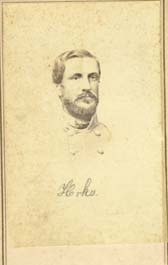
Hoke as a Colonel
The outbreak of war in 1861 found him managing his families
various manufacturing enterprises, which included a cotton mill
and iron-works. He entered the Confederate military as a
lieutenant of the 1st North Carolina Volunteers, with which
he took part in the battle of Big Bethel.
Hoke was subsequently promoted major and lieutenant
colonel of the 33rd North Carolina and colonel of the 21st.
Hoke made a distinguished record on all the battlefields of
Lee’s Army of Northern Virginia from the Seven Days to
the campaign of Chancellorsville. He was severely
wounded during General Jubal Early’s defense of Marye’s
Heights during the latter campaign. In the meantime, he had
been appointed brigadier general to rank from January
17, 1863 for gallant service at Fredericksburg.
After his recovery he was stationed in North Carolina,
suppressing desertion and outlawry in the western part of
the State; and later in eastern North Carolina. For his brilliant
exploit in capturing Plymouth and its garrison of 3000 Northerners,
he was promoted major general by President Davis from April
20, 1864. He aided Beauregard in bottling up Butler at
Drewry’s Bluff and in the repulse of Grant at Cold Harbor;
and his division was again ordered to North Carolina in
December 1864. After participating in the defense of
Fort Fisher and the Wilmington campaign, he served
gallantly under Joseph E. Johnston at Bentonville
until the final surrender.
His soldiers loved him and his final words to them were:
“You are paroled prisoners---not slaves; the love of liberty
which led you in the contest burns now as brightly in your
hearts as ever; cherish it, nourish it and associate it with
the history of the past. Transmit it to your children.
Teach them the rights of freemen and teach them to
maintain them. Teach them too that the proudest day
in all your proud careers was that on which you enlisted
as Southern soldiers.”
Captain Samuel A. Ashe said: “Hoke was Lee’s best
general and the most distinguished soldier in North Carolina.”
After the war General Hoke returned to private pursuits and
refused all political honors. He did with reluctance accept
the appointment from Governor Vance as State Director
of the North Carolina Railroad and held that position for
a few years. General Hoke's nephew, Hoke Smith, became
a successful attorney who provided legal advice to the
General's railroad operations. Smith would become
Secretary of the Interior in Grover Cleveland's
second administration.
On January 7, 1869 he married Lydia VanWyck and they
had six children, one of whom, Dr. Michael Hoke, became
a distinguished orthopedic surgeon in Atlanta. General Hoke
for awhile operated the Cranberry Iron Works and was also
president of the North Carolina Home Insurance Company
in Raleigh where he lived for many years. On July 3, 1912,
he died in Raleigh and was buried with military honors from
the Church of the Good Shepherd (Episcopal)
of which he was a member.
Sources:
The Wilmington Campaign, Mark A. Moore, Savas Publishing, 1999
The Last Rays of Departing Hope, Chris Fonvielle, Savas Pub'g, 1997
Generals in Grey, Ezra J. Warner, LSU Press, 1959
The Story of Orton Plantation, James L. Sprunt, 1958
Land of the Golden River,, Lewis P. Hall, Hall’s Enterprises, 1980
Annals of Lincoln County, Wm Sherrill, Regional Publishing, 1937
Lee’s Modest Warrior, Robt F. Hoke, Daniel Barefoot, JF Blair,1996
General William J. Hardee, Nathaniel C. Hughes, J., LSU Press, 1965
Remembering NC's Confederates, M. Hardy, Arcadia Publ'g, 2006
Hoke Smith, Dewey W. Grantham, LSU Press, 1958
©2006 Cape Fear Historical Institute